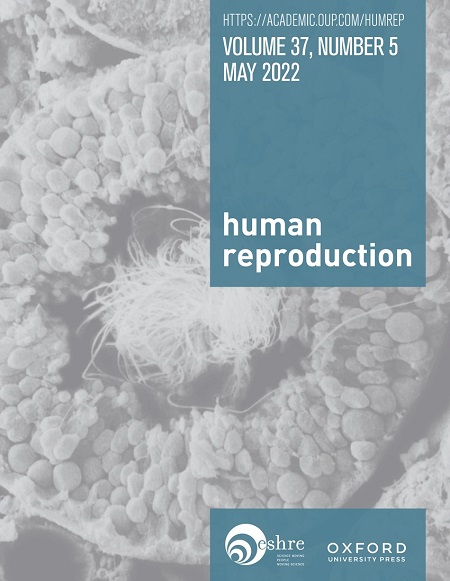胚胎大小和生长与不良出生结果:鹿特丹围孕期队列
IF 6
1区 医学
Q1 OBSTETRICS & GYNECOLOGY
引用次数: 0
摘要
研究问题 怀孕头三个月的早期胚胎大小和生长是否与不良出生结局有关?概括解答 较大的胚胎冠臀长(CRL)和胚胎体积(EV)与较低的不良出生结局几率有关,尤其是小于胎龄(SGA)。已知信息 早产、SGA 和先天性畸形是最常见的不良出生结局,会对健康造成终身影响,并产生高昂的医疗和社会成本。在妊娠晚期的前三个月和后三个月,可通过二维超声波造影(US)来识别有不良出生结局风险的胎儿。研究设计、规模、持续时间 2009 年至 2018 年间,鹿特丹围孕期队列正在进行前瞻性研究,对单胎妊娠进行了登记。参与者/材料、地点、方法 该研究包括来自荷兰一家三级医院的 918 名孕妇。妊娠日期的确定依据是规律的月经周期(自然妊娠)或受孕日期(人工流产妊娠)。CRL和EV是通过虚拟现实软件对三维(3D)超声扫描进行测量的,这些扫描在妊娠7周、9周和11周时反复进行。主要结果指标为不良出生结局,即SGA(出生体重及格线第10百分位)、早产(妊娠第37周)、先天性畸形(欧洲标准)、死胎(妊娠第16周)或早期新生儿死亡(出生后7天内)的综合结果。构建了 CRL 和 EV 的参考曲线。对参与者的受教育程度、吸烟、胎次、年龄、体重指数、地理背景、受孕方式和胎儿性别进行了调整,并进行了横向(妊娠 7、9 和 11 周的 CRL/EV <20百分位数)和纵向(妊娠 6 至 13 周的 CRL/EV 生长轨迹)回归分析。主要结果和偶然性的作用 在纳入的 918 名孕妇中,年龄中位数为 32.3 岁,有 404 名(44%)孕妇是通过 ART 受孕的。199名孕妇(22%)出现了不良分娩结局。回归分析表明,从妊娠 7 周开始,CRL <20 百分位数的胚胎出现不良出生结果的几率增加了 2 倍(调整几率比 (aOR) 2.03,95% CI 1.21-3.39,P = 0.007)。EV<20百分位数也有类似的关联,但无统计学意义。这些发现主要是由于胚胎大小与 SGA 之间的密切联系(例如,7 周 CRL:aOR 2.18 (1.16-4.09),P = 0.02;9 周 EV:aOR 2.09 (1.10-3.97,P = 0.02))。CRL的纵向生长轨迹与不良出生结局相关,而EV的纵向生长轨迹与不良出生结局无关。CRL和EV的生长轨迹均与SGA相关。局限性和注意事项 三甲医院人群和复杂的三维超声技术的可用性限制了本研究在普通人群和环境中的推广性。研究结果的广泛影响 在怀孕前三个月的早期,就可以通过使用三维超声波和虚拟现实技术识别出不良出生结果风险增加的胚胎。这拓展了未来开发干预措施的机会之窗,从而有可能改善妊娠结局和后代一生的健康状况。研究经费/合作利益 本研究由荷兰鹿特丹伊拉斯谟大学医学中心妇产科系资助。作者声明无利益冲突。试验注册号 NL4115。本文章由计算机程序翻译,如有差异,请以英文原文为准。
Embryonic size and growth and adverse birth outcomes: the Rotterdam Periconception Cohort
STUDY QUESTION Is early embryonic size and growth in the first trimester of pregnancy associated with adverse birth outcomes? SUMMARY ANSWER Larger embryonic crown–rump length (CRL) and embryonic volume (EV) are associated with lower odds of adverse birth outcomes, especially small for gestational age (SGA). WHAT IS ALREADY KNOWN Preterm birth, SGA, and congenital anomalies are the most prevalent adverse birth outcomes with lifelong health consequences as well as high medical and societal costs. In the late first and second trimesters of pregnancy, fetuses at risk for adverse birth outcomes can be identified using 2-dimensional ultrasonography (US). STUDY DESIGN, SIZE, DURATION Between 2009 and 2018, singleton pregnancies were enrolled in this ongoing prospective Rotterdam Periconception Cohort. PARTICIPANTS/MATERIALS, SETTING, METHODS This study included 918 pregnant women from a tertiary hospital in the Netherlands. Pregnancy dating was based on either a regular menstrual cycle (for natural pregnancies) or a conception date (for ART pregnancies). CRL and EV were measured using Virtual Reality software on 3-dimensional (3D) ultrasound scans, repeatedly performed around 7, 9, and 11 weeks of gestation. The main outcome measure was adverse birth outcome, defined as the composite of SGA (birth weight <10th percentile), preterm birth (<37th week of gestation), congenital anomalies (Eurocat criteria), stillbirth (>16th week of pregnancy), or early neonatal mortality (≤7 days of life). Reference curves for CRL and EV were constructed. Cross-sectional (CRL/EV <20th percentile at 7, 9, and 11 weeks of gestation) and longitudinal (CRL/EV growth trajectories between 6th and 13th weeks) regression analyses were performed, with adjustments for the participants’ educational level, smoking, parity, age, BMI, geographical background, mode of conception, and fetal sex. MAIN RESULTS AND THE ROLE OF CHANCE Of the 918 pregnant women included, the median age was 32.3 years, and 404 (44%) pregnancies had been conceived via ART. In 199 (22%) pregnancies, there was an adverse birth outcome. Regression analyses showed that at 7 weeks of gestation onwards, embryos with a CRL <20th percentile had an ∼2-fold increased odds of adverse birth outcome (adjusted odds ratio (aOR) 2.03, 95% CI 1.21—3.39, P = 0.007). Similar associations were found for EV <20th percentile but were not statistically significant. These findings were mainly driven by the strong association between embryonic size and SGA (e.g. 7-week CRL: aOR 2.18 (1.16–4.09), P = 0.02; 9-week EV: aOR 2.09 (1.10—3.97, P = 0.02). Longitudinal growth trajectories of CRL, but not of EV, were associated with adverse birth outcomes. Both CRL and EV growth trajectories were associated with SGA. LIMITATIONS, REASONS FOR CAUTION The tertiary hospital population and the availability of sophisticated 3D-ultrasound techniques limit the generalizability of this study to general populations and settings. WIDER IMPLICATIONS OF THE FINDINGS Already very early in the first trimester of pregnancy, embryos with increased risks of an adverse birth outcome can be identified by using 3D-US and Virtual Reality. This expands the window of opportunity to enable the development of future interventions to potentially improve pregnancy outcomes and offspring health during their life-course. STUDY FUNDING/COMPETING INTEREST(S) This work was funded by the Department of Obstetrics and Gynecology, Erasmus MC, University Medical Centre, Rotterdam, The Netherlands. The authors declare no conflicts of interest. TRIAL REGISTRATION NUMBER NL4115.
求助全文
通过发布文献求助,成功后即可免费获取论文全文。
去求助
来源期刊

Human reproduction
医学-妇产科学
CiteScore
10.90
自引率
6.60%
发文量
1369
审稿时长
1 months
期刊介绍:
Human Reproduction features full-length, peer-reviewed papers reporting original research, concise clinical case reports, as well as opinions and debates on topical issues.
Papers published cover the clinical science and medical aspects of reproductive physiology, pathology and endocrinology; including andrology, gonad function, gametogenesis, fertilization, embryo development, implantation, early pregnancy, genetics, genetic diagnosis, oncology, infectious disease, surgery, contraception, infertility treatment, psychology, ethics and social issues.
 求助内容:
求助内容: 应助结果提醒方式:
应助结果提醒方式:


